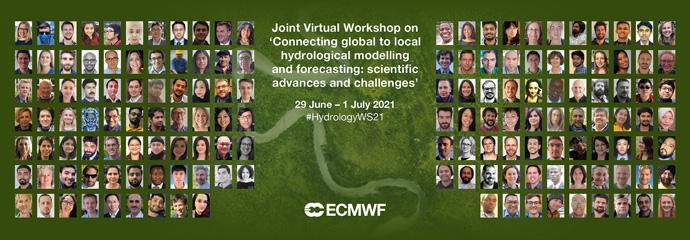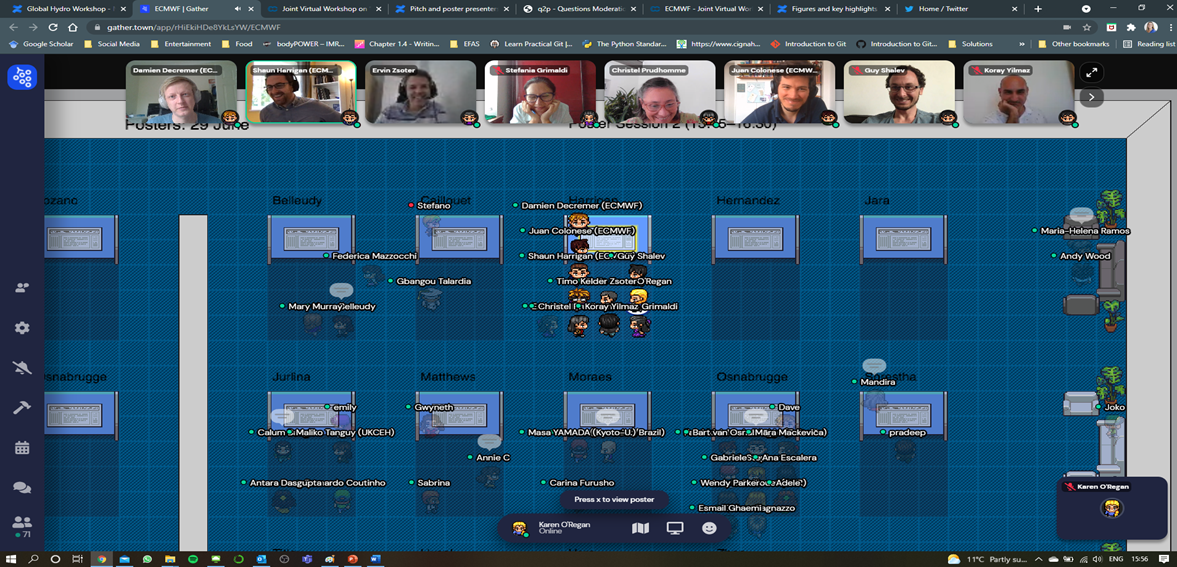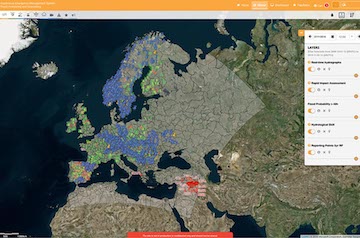
by Karen O’Regan, Ilias Pechlivanidis & Maria-Helena Ramos
Close to 600 people registered for the Joint Virtual Workshop on "Connecting global to local hydrological modelling and forecasting: scientific advances and challenges" which ran from 29 June 2021 to 01 July 2021. Attendance for the event was impressive – with over one thousand unique attendees viewing the livestreamed presentations on ECMWF’s virtual event platform and over 70 attending each of the interactive poster sessions in gather.Town.
The sessions were headlined by six excellent keynote talks from our guest speakers on various subjects of interest to the wider hydrological community. We received submissions of nearly 100 abstracts on hydrology and related topics presented in poster format which described work ranging from global hydrology, earth observation and machine learning, to catchment-scale modelling and forecasting, with links to local decision making. Recordings of keynote talks and presentation slides can be viewed on the dedicated workshop webpage.
Irina Sandu (ECMWF) introduced the European Commission’s Destination Earth (DestinE) programme. The programme aims to advance further the Earth system modelling across all scales. This is a key effort that will not only develop a high precision model of the Earth but also provides information to support sustainable development and environmental policy making. It is expected to include hydrological extremes (floods and droughts) for a better understanding of their drivers and impacts on building resilience under future climate conditions. Coordinated model development efforts between the atmosphere/land and hydrology communities are anticipated.
Wendy Parker (Virginia Tech) analysed the perspective of uncertainty communication within the hydrological modelling sphere, where large sets of ensembles are currently considered as a state-of-the-art. The keynote talk emphasised the need to change the way we view our models: from a mirror view, where models are perceived as faithful representations of the world and improving a model means adding detail and/or increasing fidelity, to a fit-for-purpose modelling view, where models are seen as representational tools that should be adequate/fit for a wide range of purposes of interest.
Liz Stephens (University of Reading) focused on the use of global forecasting for anticipatory humanitarian action, while highlighting the need to strengthen partnerships with local communities to improve the relevance and value of emergency management services. One of the main key messages delivered was that global forecasts can provide a consistent source of information to local authorities, with longer lead times and state-of-the art ensemble forecasts. However, on their own, they are not building national capacity. More work is needed to facilitate feedback from national hydrometeorological and engagement on systems’ developments.
Micha Werner (IHE Delft) introduced a human-centred approach that more explicitly considers local needs, knowledge, and policy contexts, to evolve large-scale climate services and ensure their uptake for addressing users’ challenges. With examples on water allocation, flash flood forecasting and rain-fed agriculture from all over the world, it was shown how different perspectives need to be considered when evaluating how good or how useful a forecast is. Listening to what local people have to say is as important as listening to our data and global models.
Louise Slater (University of Oxford) provided an overview of the recent developments with statistical models, including machine learning, and their applications to predict different hydroclimatic variables. She discussed the emergence of hybrid (dynamical/statistical) hydrological forecasting alongside traditional approaches and highlighted some potential strengths of hybrid forecasting; operational convenience (post-processing), learning from nonstationary predictors, reducing biases, combining sources of predictability. The remaining key challenges pointed out to data requirements, physical plausibility of model outputs and the assimilation of human influences in water systems.
Guy Schumann (University of Bristol) provided an overview of the advances in Earth Observation (EO) technologies and conveyed the opportunities EO advancements could offer to flood modelling and forecasting. The need to democratize availability, access and affordability of commercial EO data was highlighted. A call for action to the effective integration of the latest advances and capabilities of EO and Earth system modelling was issued towards, routinely evaluating flood forecasts, diagnosing forecast problems, and developing novel initialization, calibration, and post-processing procedures to deliver more skilful and reliable forecasts at longer lead times globally.
High-quality research was also presented during the poster presentations, which covered six broad themes, from challenges and advances in modelling hydrologic variables at large scales (coupled water prediction systems), to catchment-scale hydrometeorological forecasting (nowcasting, short, medium and long ranges), monitoring, modelling and forecasting flood risk, and inundation mapping. Impact assessments and connections of large-scale water-cycle information to local needs, knowledge and decision making were also central to the workshop.
Several posters addressed challenges and new techniques on post-processing model outputs and evaluating forecast skill. The use of Earth Observations and data assimilation for hydrological forecasts and past reanalyses was explored as opportunities to better link global to local scales. The community has been investigating new methodologies and practices that clearly are a step beyond the current state-of-the-art. All posters presented during the workshop are available on the posters page of the workshop website. We strongly invite you to view the posters or directly contact the authors and initiate a fruitful scientific exchange of knowledge.

All interactive aspects including poster sessions, the Sci-Art event, CDS/CEMS/C3S information booths, and networking breaks were hosted on ECMWF’s gather.Town platform. This method of hosting the workshop received much positive feedback from attendees, who enjoyed its game-like feel and ‘natural’ networking opportunities. One attendee stated: “The workshop was really engaging. The ‘virtual ECMWF’ on Gather Town was a big hit. It allowed our hydrological community to interact at a more intensive level. The poster sessions felt very natural with people ‘walking’ past and many small group discussions were ignited. There was even an Early Career hangout room that again provided fantastic networking opportunities.”
The workshop was organised by a collaborative effort from the European Centre for Medium-range Weather Forecasts (ECMWF), the Copernicus Emergency Management Service (CEMS), the Copernicus Climate Change Service (C3S), the Hydrological Ensemble Prediction EXperiment (HEPEX) and the Global Flood Partnership (GFP). Six chairs hosted the ensemble of discussions, Hannah Cloke (University of Reading, UK), Christel Prudhomme (ECMWF, UK), Maria-Helena Ramos (INRAE, France), Peter Salamon (European Commission, Joint Research Centre, Italy), and Ilias Pechlivanidis (SMHI, Sweden), with the support of Karen O’Regan (ECMWF).
The workshop was an excellent opportunity to showcase the hard work and inspiring science being produced within the global hydrological community. We extend our thanks to those who contributed to and attended this impressive virtual event!

